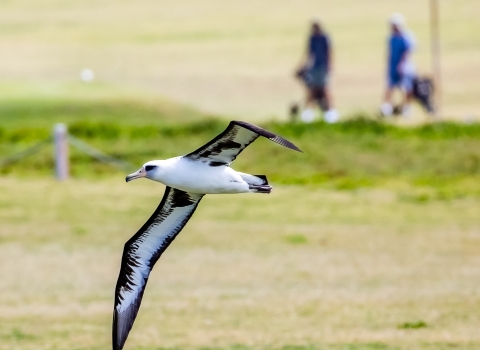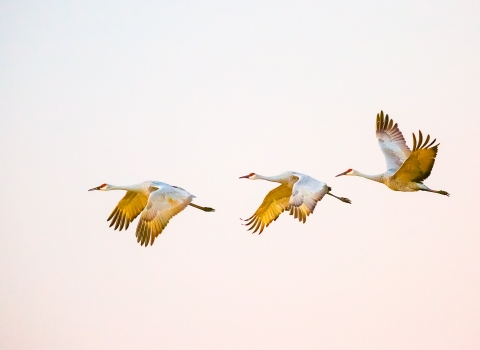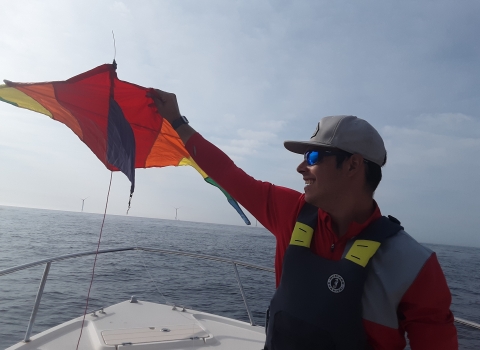What is the issue?
Loss, degradation and fragmentation of important migratory bird habitat have been identified as potentially the largest individual threat to migratory birds. Much of this is human caused by development. Birds need essential resources for breeding, feeding, shelter, and survival, including access to food, water, and nesting sites. The size and connectivity of habitat (e.g. whether it is large and intact vs. fragmented and isolated) can dictate whether or not the habitat will meet certain birds’ needs.
During a bird’s annual life-cycle, habitat use may vary. For instance, many birds migrate south to other countries for the winter. They may stop to re-fuel along the way to enable them to complete their long journey. Others remain in a particular habitat during the entire year, or move only slightly north or south in elevation or longitude as the seasons change.
Quality habitat is extremely important during breeding season, when many birds nest in trees, shrubs, on the ground, or on rocks and rely on nearby resources to raise healthy young. If that habitat is destroyed or disturbed during the breeding season, nests may be lost or abandoned or productivity may be reduced. Loss and degradation of quality bird habitats can lead to population declines at a local and national scale.
Why does this happen?
Development has accelerated nationwide to meet increasing societal demands for food, space, and energy. This development can result in habitat loss, degradation, change, or fragmentation, reducing the availability of resources to meet the needs of birds. It is increasingly important to identify, conserve, and protect important bird habitats.
Exacerbating human development impacts are the changes in habitats resulting from a changing climate. Effects of climate change climate change
Climate change includes both global warming driven by human-induced emissions of greenhouse gases and the resulting large-scale shifts in weather patterns. Though there have been previous periods of climatic change, since the mid-20th century humans have had an unprecedented impact on Earth's climate system and caused change on a global scale.
Learn more about climate change can alter resource availability, increasing the stress on already limited resources.
What are some solutions?
Because habitat resources are essential to the health and survival of migratory birds and their young, protecting habitats that birds use throughout their annual cycle, and minimizing threats within those habitats, is critical to ensuring healthy and sustainable bird populations as a whole.
Several actions can help to protect and conserve important bird habitat, including:
- Climate change research and habitat change predictions – Because climate change has such a powerful impact on bird habitats and resources, it is important to understand how and where these effects will be manifested, so that we can proactively preserve landscapes that supports healthy bird populations.
- Habitat restoration and conservation efforts - Habitat restoration can be a powerful conservation tool for maintaining healthy bird populations. The Service works with partners to promote and assist with habitat restoration and conservation areas across the nation through grant programs, migratory bird management plans and various partnership initiatives. For endangered species, the Service works with developers to implement Habitat Conservation Plans aimed at preserving habitats listed species depend on.
- International coordination – Because birds often travel outside of U.S. borders throughout the year, it is important not only to maintain quality habitat for birds inside the U.S., but also other areas around the world where birds migrate and winter. The Service coordinates with international partners on cooperative initiatives such as:
- Trilateral Committee (U.S. – Mexico –Canada)
- Ramsar Wetlands Convention
- US-Russia Environmental Agreement
- Migratory Bird Conventions (Treaties) with Canada, Mexico, Japan and Russia
- US-China Conservation Protocol
- Western Hemisphere Migratory Species Initiatives
- Habitat mitigation – Sometimes loss of important habitats cannot be avoided during the process of an activity. When this happens, one option is to create habitat that will benefit the affected species elsewhere, reducing the effects of the lost habitat.
- Smart project siting – The best way to avoid habitat impacts is to avoid placing development and energy projects in or near important bird habitat. Some areas are already protected from development, such as national parks, national wildlife refuges and state parks and protected Areas. Others, like important bird areas, are identified important areas for certain birds, but may not have any particular activity or development avoidance protections required. Many areas are not well known and need to be identified through consultation with wildlife experts. To help project planning and siting, spatial data and tools are available to help developers proactively evaluate locations that might have the fewest impacts to bird habitat. These tools save developers and environmental agencies money and time, while helping to protect important migratory bird resources.
- Minimizing habitat impacts - There are also some very simple vegetation management measures that developers, landscapers and others can follow to preserve important nesting habitat during the breeding season and restore native vegetation that many birds use and depend on. To learn more about "/birds/management/project-assessment-tools-and-guidance/conservation-measures.php" Conservation Measures.
The following tools and resources may be helpful when assessing where to locate your project:
- Avian Knowledge Network (AKN) – The Avian Knowledge Network is a partnership of individuals, institutions and government agencies supporting the conservation of birds and their habitats based on data, adaptive management, and the best available science. AKN partners improve awareness, purpose, access to, and use of data and tools at scales ranging from individual locations to administrative regions (e.g., management areas, states, countries) and species ranges.
- U.S. Fish & Wildlife Service Information for Planning and Conservation ( IPaC IPaC
Information for Planning and Consultation (IPaC) is a project planning tool that streamlines the USFWS environmental review process
Learn more about IPaC ) system – The IPaC System is designed for easy, public access to information about the natural resources for which the Service has trust or regulatory responsibility. Examples include threatened and endangered species, migratory birds, national wildlife refuge national wildlife refuge
A national wildlife refuge is typically a contiguous area of land and water managed by the U.S. Fish and Wildlife Service for the conservation and, where appropriate, restoration of fish, wildlife and plant resources and their habitats for the benefit of present and future generations of Americans.
Learn more about national wildlife refuge lands, and National Wetland Inventory wetlands. One of the primary goals of the IPaC system is to provide this information to assist people in planning activities within the context of natural resource conservation. IPaC also guides people through regulatory consultation, permitting and approval processes administered by the Service, helping achieve more effective and efficient results for both project proponents and natural resources. The IPaC System is continuously being developed to help meet the needs of Service staff and others in conserving trust resources during the project planning process. - Western Governors Association (WGA) Crucial Habitat Assessment Tool (CHAT) – CHAT is designed to reduce conflicts while ensuring wildlife values are better incorporated into land use planning, particularly for large-scale linear projects. It is non-regulatory tool and not intended for project-level approval.
- American Bird Conservancy Wind Development Bird Risk Map - This resource for wind developers, regulators, and conservationists shows areas in the United States where wind development is likely to pose an elevated risk to birds.
- American Wind Wildlife Institute (AWWI) Landscape Assessment Tool (LAT) - A GIS-based, publicly-available mapping tool that collates and displays biological information that is relevant to wind-energy development, the tool was built and is maintained by AWWI and The Nature Conservancy. Users can display web-based maps featuring information aggregated from over 1,000 data layers relevant to identifying potential wildlife and environmental impacts and landscape-level screening for potential project sites.
Note: The Service does not necessarily endorse the non-USFWS tools listed. The quality and validity of many new tools are still being verified. We highly recommend coordinating with appropriate environmental agencies to facilitate smart siting efforts and verify any environmental assessment results often and early in the project planning process.
- Strategic coordination – The Service recognizes that partnerships and coordinated efforts result in the greatest conservation success. We have embraced Strategic Habitat Conservation (SHC), which focuses less on recovering individual species, and more on recovering habitats essential to a broad range of species. This approach is aimed at coordinating the efforts and actions of the Service’s regions and programs, and leveraging partners and funding to benefit the largest number of species throughout their full range in the most efficient and effect ways possible.
- Technical assistance – The Service’s Conservation Planning Assistance and Migratory Bird programs work directly with others on infrastructure development projects to protect the environment and preserve our nation's biological resources, including migratory birds and their habitat. Field biologists in all 50 states assist project proponents, planners, and agency personnel in developing plans that conserve, restore, or enhance plant and animal species, while accomplishing the objectives of proposed development.
Our biologists fulfill numerous duties under multiple authorities, including the Migratory Bird Treaty Act, reviewing and providing recommendations on smart siting as described above, project plans and development designs, and best management practices; crafting mitigation plans; providing expertise in wildlife and habitat science; and serving on planning teams. More information on the things developers and others should know and the steps they should take to ensure different project and activities have considered and properly addressed potential impacts to migratory birds will be coming to our website soon.
For more information about measures and guidance for avoiding or minimizing impacts to migratory birds, please visit the "birds/management/project-assessment-tools-and-guidance/conservation-measures.php" Conservation Measures and "birds/management/project-assessment-tools-and-guidance/guidance-documents.php" Guidance Documents webpages.





